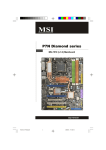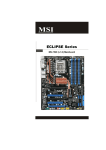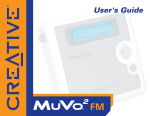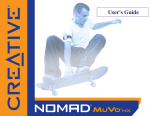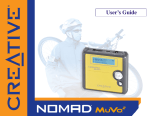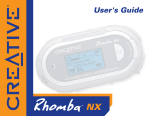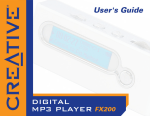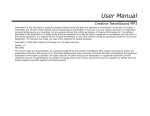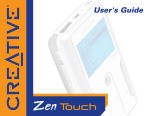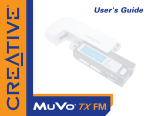Download Creative MuVo V200 User`s guide
Transcript
User’s Guide Creative MuVo V200 Information in this document is subject to change without notice and does not represent a commitment on the part of Creative Technology Ltd. No part of this manual may be reproduced or transmitted in any form or by any means, electronic or mechanical, including photocopying and recording, for any purpose without the written permission of Creative Technology Ltd. The software described in this document is furnished under a license agreement and may be used or copied only in accordance with the terms of the license agreement. It is against the law to copy the software on any other medium except as specifically allowed in the license agreement. The licensee may make one copy of the software for backup purposes. The Software License Agreement is found in a separate folder on the installation CD. Copyright © 2004 Creative Technology Ltd. All rights reserved. Version 1.0 August 2004 The Creative logo, MuVo logo and Creative MediaSource are trademarks or registered trademarks of Creative Technology Ltd. in the United States and/or other countries. Microsoft and Windows are registered trademarks of Microsoft Corporation. All rights reserved. Intel and Pentium are trademarks of Intel Corporation in the U.S. and other countries. CDDB is a trademark of CDDB, Inc. All other products are trademarks or registered trademarks of their respective owners. Contents Before You Begin Introduction ................................................................................... v Minimum System Requirements ................................................. v 1 A Tour of Your Player Your Player at a Glance ........................................................... Using the Scroller ..................................................................... Scroll Select .................................................................. Selecting menu options ................................................ 1-1 1-2 1-2 1-2 2 Getting Started Step 1: Setting Up Your Computer ........................................... Step 2: Inserting the Battery ..................................................... Power Source and Level Indicators .............................. Step 3: Transferring Audio and Data ........................................ Downloading from the internet ...................................... Ripping From A CD ...................................................... Step 4: Stopping Your Player Properly ..................................... 2-1 2-3 2-4 2-5 2-6 2-7 2-8 3 Using Your Player Turning On/Off your Player ...................................................... Enabling a Mode ...................................................................... Playing Audio Tracks ................................................................ Deleting Audio Tracks .............................................................. Managing Audio Tracks ............................................................ Skipping Folders ....................................................................... Listening to FM Radio .............................................................. 3-1 3-2 3-2 3-3 3-3 3-4 3-4 ii Audio and FM Recording .......................................................... 3-9 Recording Audio ........................................................... 3-9 Recording FM Radio ................................................... 3-10 Playing Recordings ................................................................ 3-11 Play Modes ............................................................................. 3-12 Repeat track ............................................................... 3-13 Repeat Folder ............................................................. 3-13 Repeat All ................................................................... 3-13 Repeat Portion ............................................................ 3-14 Shuffle Once ............................................................... 3-14 Shuffle Repeat ............................................................ 3-15 Track Once ................................................................. 3-15 Normal ........................................................................ 3-15 Enhancing Audio .................................................................... 3-16 Enhancing Audio ........................................................ 3-16 Defining Custom EQ ................................................... 3-17 Setting Preferences ................................................................ 3-18 Settings ....................................................................... 3-18 Locking and unlocking your Player ......................................... 3-21 Formatting Your Player .......................................................... 3-22 Appendixes A Technical Specifications Size ................................................................... Weight ............................................................... Capacity ............................................................ Battery type ....................................................... Battery Life (playback time) .............................. A-1 A-1 A-1 A-1 A-1 iii Playback Formats ............................................. Recording Formats ........................................... Signal to Noise Ratio ........................................ Channel Separation .......................................... Frequency Response ........................................ Harmonic Distortion .......................................... Operating System/Firmware ............................. Headphone Out ................................................ LCD Display ...................................................... Data Connector ................................................. Firmware Support ............................................. A-1 A-1 A-1 A-2 A-2 A-2 A-2 A-2 A-2 A-2 A-2 B Onscreen Diagram and Icon Guide Information Diagrams ............................................................... Playback Icons ......................................................................... Play Mode Icons ....................................................................... Error Diagrams ......................................................................... B-1 B-2 B-3 B-4 C Frequently Asked Questions AutoPlay ................................................................................... General ..................................................................................... Usage ....................................................................................... Digital Rights Management ...................................................... C-1 C-1 C-2 C-3 iv Before You Begin Before You Begin Introduction Thank you for purchasing Creative’s new multi-format player, Creative MuVo® V200! Your player can store thousands of songs in its music library, and comes equipped with an USB 2.0™ connector, so you can transfer audio tracks and data quickly and easily. Your player supports WMA files protected with Digital Rights Management (DRM) technology. Minimum System Requirements ❍ ❍ ❍ ❍ ❍ The software applications on the MuVo V200 CD may have higher requirements for basic functionality. Refer to each application’s documentation for details. ❍ ❍ ❍ Microsoft® Windows® XP, Windows 2000, Windows Millennium Edition (Me) or Windows 98 Second Edition (SE) Intel® Pentium® II 350 MHz, AMD® K6-2® 450 MHz or better processor (Pentium III 450 MHz or higher recommended for MP3 encoding) CD-ROM drive with digital audio extraction support USB 1.1 port (USB 2.0 port recommended) 64 MB RAM (128 MB recommended) 30 MB free hard disk space (more needed for storing audio) Functioning mouse SVGA graphics adapter (256 colors, 800 x 600 resolution or better) v A Tour of Your Player A Tour of Your Player Your Player at a Glance Battery module Earphone jack Scroller Play/Pause button Microphone USB Flash Drive Volume Increase button Volume Decrease button LCD (Liquid Crystal Display) USB connector Front View Side View A Tour of Your Player 1-1 Using the Scroller Scroll Select To "Scroll Select", use the Scroller to scroll to the option you want, and select the option by pressing the Scroller. Selecting menu options The Scroller is one of the most important features of your player. In this document, we will use the term, “Scroll Select”, to mean that you should use the Scroller to scroll through options, and then select the option by pressing the Scroller. The Scroller (side view) Use the Scroller to scroll through options Press the Scroller to select an option You can use the Scroller to make selections in menus. For example, if you are looking at the Menu screen: From the Menu screen to the Play Mode Options screen 1. Use the Scroller to scroll through the menu options. 2. Press the Scroller to select the menu item. A Tour of Your Player 1-2 Button What It Does Usage Tips ❍ PLAY/PAUSE ❍ ❍ ❍ Turns the player on and off. Activates the LCD backlight. Starts, pauses or continues playback. ❍ Increases the volume. ❍ Decreases the volume. To turn on your player, press and hold until the MuVo V200 logo appears on the screen. ❍ To turn off your player, press and hold until the Power off message appears. ❍ When your player is locked, press to turn on the LCD backlight. VOLUME INCREASE ❍ Press and hold to increase the volume quickly. ❍ Press and hold to decrease the volume quickly. VOLUME DECREASE ❍ ❍ SCROLLER Goes to the previous or next track. ❍ Moves ahead or moves back within a track. ❍ Scrolls through menu options. ❍ Selects menu options. During playback, turn the Scroller to go to the previous or next track. ❍ During playback, turn and hold the Scroller to move ahead or move back within a track. ❍ Turn the Scroller to scroll through menu options and press the Scroller to select them. This action is also referred to as "Scroll Select". A Tour of Your Player 1-3 Getting Started Getting Started Step 1: Setting Up Your Computer Windows 98 SE users must install the drivers to transfer tracks or files to the player. To set up your player, Windows 2000 and Windows XP users must log in as the computer administrator. For more information, refer to your operating system’s online Help. Your player comes with drivers for Windows 98 SE, together with software that helps you create audio tracks, manage your music library and use your player. Windows XP, Windows 2000 and Windows Me users do not need to install drivers. 1. Make sure that your player is NOT connected to your computer. 2. Insert the MuVo V200 CD into your CD-ROM/DVD-ROM drive. Your CD should start automatically. If it does not, follow the steps below: i. Start Windows Explorer. ii. On the left pane, click the My Computer icon. iii. Right-click the CD-ROM/DVD-ROM drive icon, and then click AutoPlay. 3. Click the MuVo V200 software option to select it. 4. Click the OK button. 5. Follow the instructions on the screen. Creative MediaSourceTM and Windows 98 SE drivers (only if applicable) will be installed on your computer. 6. If prompted, restart your computer. Getting Started 2-1 7. Connect your player to your computer. a Your computer’s USB port may be located on the back panel. If your USB Flash Drive does not fit into the USB port located on the front panel, connect it to the USB port located on the back panel. Do not press the buttons on your USB Flash Drive while connecting it to your computer. USB Flash Drive USB connector Battery module b USB port Getting Started 2-2 Step 2: Inserting the Battery a b c Getting Started 2-3 Power Source and Level Indicators The amount of playback time available depends on various factors (for example, volume level used). For more information, see "Usage" on page C-2. After inserting the battery, your player displays one of the following icons, depending on the battery’s status. Icon What the icon means ❍ your player’s battery is full ❍ your player’s battery is 60% full ❍ your player’s battery is 30% full ❍ your player’s battery is nearly empty Notes ❍ this battery state icon shows that the battery is full ❍ change the battery at the earliest opportunity Getting Started 2-4 Step 3: Transferring Audio and Data If you wish to download additional music tracks to your player, you can either download music tracks from Internet music sites (see "Downloading from the internet" on page 2-6) or rip them from your audio CDs to create digital files on your computer. For more information, see "Ripping From A CD" on page 2-7. Music files can be encoded into the supported formats (MP3 or WMA file formats), then transferred to your player with Creative MediaSource Organizer. To listen to transferred audio tracks, your player must be in Music mode. For more information, refer to "Using Your Player" on page 3-1. Data files can also be transferred and stored in your player, for example, you can transfer a large data file from one computer to another. To transfer audio and data with Creative MediaSource 1. Connect your player’s USB Flash Drive to your computer’s USB port. 2. Launch Creative MediaSource on your computer. 3. On the left pane, locate and select the files you want to transfer to your player. Using the standard drag-and-drop method, transfer the files to your player. For information about transferring DRM protected WMA files, refer to "Digital Rights Management" on page C-3. 4. After the transfer is complete, make sure you stop your player properly before disconnecting it from your computer. For more details, see "Step 4: Stopping Your Player Properly" on page 2-8. Getting Started 2-5 Downloading from the internet To get MP3 files from the Internet, use a search engine to locate sites with MP3 content. You can use your player to download audio files from all the major Internet music download services. ❍ It may be illegal to encode MP3 files for trade or sale unless you have the express or explicit permission of the copyright holder(s). Walmart.com http://www.music downloads.walmart.com ❍ Buy.com ❍ Epitonic.com http://www.buy.com ❍ Bestbuy.com ❍ Soundbuzz.com http://www.bestbuy.com http://www.soundbuzz.com http://www.epitonic.com Follow the instructions on the site and download the music files to your computer. When connecting to your Internet Service Provider, usage charges are incurred. Getting Started 2-6 Ripping From A CD To get music tracks from your CDs to your player, you will need a CD-ROM drive that can extract digital audio data, and Creative MediaSource Organizer. Creative MediaSource Organizer will read the audio information on your CD and convert it to MP3 files using the bitrate you choose. Rather than manually entering track information, retrieve such audio CD information from CDDB before ripping tracks. Change the default ripping format and bitrate for higher or lower quality audio. See Creative MediaSource’s online Help for details. The standard bitrate of most MP3 files is 128 Kbps, although some are set higher, at 160 or 192 Kbps. Using the standard bitrate will ensure that your MP3 files retain much of their audio quality. Higher bitrates will result in larger MP3 file sizes, with better audio quality. The time needed to successfully extract audio from a CD depends on: ❍ CD-ROM drive speed ❍ Defects, like scratches on the audio CD ❍ Error-checking features on the CD-ROM drive ❍ Bitrate selected for encoding. For more information on how to rip and encode audio CDs, see the Creative MediaSource online Help. Getting Started 2-7 Step 4: Stopping Your Player Properly To stop your player in Windows XP, Windows 2000 or Windows Me Click the Safely Remove Hardware icon on the Taskbar, click Safely remove USB Mass Storage Device, and disconnect your player when you are prompted to do so. To stop your player in Windows 98 SE In Windows Explorer, right-click the Removable Disk icon, click the Eject option, and disconnect your player when you are prompted to do so. Make sure that the icon below appears on the LCD screen for at least five seconds before disconnecting your player. Getting Started 2-8 Using Your Player Using Your Player Your player can function in Music or Recordings mode. In Music mode, only MP3 or WMA files are played back and in Recordings mode, only microphone and FM radio recordings that are recorded by the player, are played back. To switch between modes, see "Enabling a Mode" on page 3-2. Your player also has Play Modes that allow you to change how your tracks are played back. For more information, see "Play Modes" on page 3-12. Turning On/Off your Player Remember to unplug the USB Flash Drive from your computer and insert it into the battery module before turning on the player. To turn on your player Press and hold the Play/Pause button If your player contains no audio tracks, the message "No Music" or "No Recording" will appear on the screen, depending on whether you are in Music or Recordings mode. until your player turns on. The CREATIVE logo appears on the screen, followed by the MuVo V200 logo. Audio tracks stored in your player are automatically played back. To turn off your player Press and hold the Play/Pause button message disappears. until the Power off Using Your Player 3-1 Enabling a Mode Your player can function in Music or Recording mode.Different modes enable you to select different functions. 1. Press the Scroller. The Main Menu (Figure 3-1) appears. 2. Scroll Select the Music icon or Recordings Figure 3-1 icon . Playing Audio Tracks To add audio tracks to your player, see "Step 3: Transferring Audio and Data" on page 2-5. Follow these steps to play audio tracks. Audio tracks are sorted in alphanumeric order. 1. Press the Play/Pause button until the MuVo V200 logo appears on the screen, and audio tracks stored in your player are automatically played back. Play Mode Icon Elapsed time Battery Level Indicator Play Status Icon EQ Setting Icon Music Mode Icon Track Title To pause a track Press the Play/Pause button . To stop a track Press the Play/Pause button to pause the track. Turn the Scroller towards the left to resume playback at the beginning of the track or turn the Scroller towards the right to resume playback at the beginning of the next track. The Stop icon appears on the screen. Using Your Player 3-2 Deleting Audio Tracks This action permanently deletes tracks from your player. To delete a track 1. In Music mode, select the track that you want to delete. 2. Press the Scroller. 3. Scroll Select the Delete icon (Figure 3-2). A list appears. Figure 3-2 4. Scroll Select the Delete icon (Figure 3-3). The track’s name appears on the screen and the track is permanently deleted from your player. Figure 3-3 Managing Audio Tracks For more information about using Creative MediaSource, refer to its online Help. For more advanced song management tasks, such as creating and managing playlists, you can use Creative MediaSource Organizer. Creative MediaSource Player/Organizer is your digital audio center for playing, creating, organizing and transferring digital audio. To launch Creative MediaSource Player/Organizer, double-click the Creative MediaSource Player/Organizer icon on your desktop. Using Your Player 3-3 Skipping Folders Your player can only recognize up to one sub folder level in the root directory. Listening to FM Radio This action skips the playback to a selected folder. To go to the next folder 1. 2. 3. 4. Press the Scroller. Scroll Select the Skip Folder icon (Figure 3-4). Scroll to the folder that you want to go to. To resume normal playback, press the Scroller again. Figure 3-4 With your player, you can listen to your favorite radio station. Your player can automatically scan for stations available in your region, and store the stations as channels for you. In FM Radio mode, your player will display the current radio channel and its preset number. FM radio channel If there are no saved preset channels in your player, the "No preset found" message will appear on the screen. Battery Level Indicator FM radio mode Stereo/Mono Indicator Preset number Figure 3-5 Using Your Player 3-4 To change the FM region Only two FM regions are available — International and Japan. Perform these steps when scanning for stations for the first time. 1. Press the Scroller. The Main Menu (Figure 3-6) appears. Figure 3-6 2. Scroll Select the Settings icon (Figure 3-7). A list appears. Figure 3-7 3. Scroll Select the FM Region icon (Figure 3-8). A list appears. 4. Scroll Select the region that you are in. Figure 3-8 To perform an autoscan and autosave 1. Connect your earphones to the earphone jack. 2. Press the Scroller. The Main Menu similar to Figure 3-9 appears. 3. Scroll Select the FM Radio icon (Figure 3-10). A radio frequency appears on the LCD screen (Figure 3-11). 4. Press the Scroller. 5. Scroll Select the Autoscan icon (Figure 3-12). The player scans and stores channels it detects. At the end of the autoscan, it automatically saves all channels plays the first channel. Figure 3-9 Figure 3-10 Figure 3-11 Figure 3-12 Using Your Player 3-5 To manually set a preset channel 1. Press the Scroller. The Main Menu similar to Figure 3-13 appears. Figure 3-13 2. Scroll Select the FM Radio icon (Figure 3-14). A radio frequency appears on the LCD screen (Figure 3-15). Figure 3-14 3. If you see a preset channel, press the Play/ 4. Turn the Scroller towards the right to increase the frequency or towards the left to decrease the frequency. 5. 6. 7. 8. Pause button to switch to Manual Scan view. The preset channel disappears. To scan for a channel, turn the Scroller towards the right or left, and hold for one second. Press the Scroller. Scroll Select the Save Preset icon (Figure 3-16). Turn the Scroller to select the preset number you want. Your channel is stored and appears at the bottom-left corner of your screen. Repeat steps 2 to 6 to store another channel. Figure 3-15 Figure 3-16 Using Your Player 3-6 To select a channel 1. Press the Scroller. The Main Menu similar to Figure 3-17 appears. Figure 3-17 2. Scroll Select the FM Radio icon (Figure 3-18). A radio frequency appears on the LCD screen (Figure 3-19). Figure 3-18 If you do not see a preset channel, press the Play/Pause button. 3. Turn the Scroller to select the preset channel you want. To delete a preset channel Figure 3-19 1. Press the Scroller. The Main Menu similar to Figure 3-20 appears. Figure 3-20 2. Scroll Select the FM Radio icon (Figure 3-21). A radio frequency appears on the LCD screen (Figure 3-22). Figure 3-21 If you do not see a preset channel, press the Play/Pause button. 3. Turn the Scroller to select the preset channel you want. 4. Press the Scroller. Figure 3-22 Using Your Player 3-7 5. Scroll Select the Delete Preset icon (Figure 3-23). Figure 3-23 6. Scroll Select the Delete Preset x icon (Figure 3-24). The preset channel is deleted and your player plays the next available preset channel. Figure 3-24 To switch to FM Preset view or Manual Scan view In FM Preset view, you can see the preset channels and scroll from one preset channel to another. If you need to fine-tune the radio channel, switch to Manual Scan view. 1. Press the Scroller. The Main Menu similar to Figure 3-25 appears. Figure 3-25 2. Scroll Select the FM Radio icon (Figure 3-26). A radio frequency appears on the LCD screen (Figure 3-27). Figure 3-26 3. Press the Scroller. Figure 3-27 4. Scroll Select the Scroller mode icon (Figure 3-28) to switch to the different views. Alternatively, you can press the Play/Pause button to switch to the different views while playing a station. Figure 3-28 Using Your Player 3-8 Audio and FM Recording Another great MuVo V200 feature is its ablility to record audio and FM radio. Recorded audio is encoded directly into IMA ADPCM (at 8 kHz, 4-bit, Mono) file format and recorded FM radio is encoded directly into IMA ADPCM (at 16 kHz, 4-bit, Stereo) file format. When recording, note that the available recording time is determined by: ❍ ❍ Recording Audio available space in your player battery power remaining in your player When recording, you will see the time available for recording. You will also see a bar showing you the elapsed recording time. Elapsed Recording Time You cannot pause and continue a voice recording. Remaining Time Available For Recording To make a recording 1. Press the Scroller. Scroll Select the Microphone icon (Figure 3-29). The recording bar appears on the screen. Figure 3-29 2. Press the Play/Pause button recording. to start the 3. Press the Play/Pause button again to end the recording. A name is automatically assigned to your recording and it is saved in your player. The naming convention used is: VOC [Current File Number]. Using Your Player 3-9 Recording FM Radio When recording FM radio, you will see one bar showing you the time available for recording, and another showing you the elapsed recording time. Also the FM Radio icon appears in the bottom-left corner of the LCD screen. Elapsed recording time You cannot pause and continue a FM radio recording. Battery level indicator Play status icon Remaining time available for recording FM Radio mode Figure 3-30 To make an FM radio recording If you do not see a preset channel, press the Play/Pause button. 1. Press the Scroller. The Main Menu similar to Figure 3-31 appears. Figure 3-31 2. Scroll Select the FM Radio icon (Figure 3-32). A radio frequency appears on the LCD screen (Figure 3-33). Figure 3-32 3. Turn the Scroller to select the preset channel you want. 4. Press the Scroller. Figure 3-33 5. Scroll Select the FM Recording icon (Figure 3-34). A recording bar appears on the LCD screen and recording starts. Figure 3-34 Using Your Player 3-10 6. Press the Play/Pause button to end the recording. A name is automatically assigned to your FM radio recording and the file is saved in your player. The naming convention typically used is: FM [Current File Number]. Playing Recordings It is simple to play back the audio and FM Radio tracks you have recorded. In Recordings mode, your player will display the elapsed time, track number and file name of the recorded track. Play mode icon A recorded voice file name starts with "VOC" and an FM radio file name starts with "FM". Elapsed time Battery level indicator Play status icon Lock Recordings mode Current playing track name Figure 3-35 To play a recording 1. Press the Scroller. The Main Menu similar to Figure 3-36 appears. Figure 3-36 2. Scroll Select the Recordings icon (Figure 3-37). 3. Scroll Select a recording you want to listen to. The track is played back automatically. Figure 3-37 To delete a recording, see "Deleting Audio Tracks" on page 3-3. Using Your Player 3-11 Play Modes Your player has Play Modes that allow you to change how your tracks are played back. Play Modes are disabled by setting the “Normal” mode as described on page 15. The following Play Modes are available: Only one Play Mode can be enabled at a time. ❍ ❍ ❍ ❍ ❍ ❍ ❍ ❍ ❍ A-B Repeat Track Repeat All Repeat Folder Track Once Shuffle Repeat Shuffle Once Shuffle Folder Normal To enter Play Mode 1. Press the Scroller. The Main Menu (Figure 3-38) appears. Figure 3-38 2. Scroll Select the Play Mode icon. A list appears (Figure 3-39). Depending on which mode you want, follow the corresponding step: Figure 3-39 Using Your Player 3-12 Repeat track To repeat a track Scroll Select the Repeat Track icon . The Repeat Track icon appears on the screen and the track is repeated continuously until you stop it or go to another track. Repeat Folder To repeat a folder Scroll Select the Repeat Folder icon Repeat Folder Mode is only available in Music mode. Repeat All The Repeat Folder icon appears on the screen and tracks in the current folder are repeated continuously until you stop them or go to another folder. To repeat all tracks Scroll Select the Repeat All icon A portion of a track can only be repeated once; marking a new portion will automatically remove any markers in the track. . . The Repeat All icon appears on the screen and all tracks are repeated continuously until you stop playback. Using Your Player 3-13 Repeat Portion To repeat a portion of a track 1. Scroll Select the A-B icon . The icon appears, prompting you to select a start point for the portion of music to repeat. 2. Press the Scroller to mark the begining of the portion you wish to repeat. The icon appears, prompting you to select an end point for the repeat function. 3. Press the Scroller again, to mark the end point of the portion of music to repeat. The marked portion of music is played back repeatedly. 4. To resume normal playback, enable “Normal” mode as described in "Normal" on page 3-15. Shuffle Once Shuffle Folder Mode is only available in Music mode. To shuffle all tracks once Scroll Select the Shuffle Once icon. The Shuffle Once icon appears on the screen and tracks are selected in random sequence and played back. Playback stops once all the tracks in your player are played back once. To shuffle a folder once Scroll Select the Shuffle Folder icon. The Shuffle Folder icon appears on the screen and all tracks in the folder are selected at random and played back. Playback stops once all the tracks in the folder are played back once. Using Your Player 3-14 Shuffle Repeat To Shuffle Repeat all tracks continuously Scroll Select the Shuffle Repeat icon. The Shuffle Repeat icon appears on the screen. Selected tracks are in random sequence and played back continuously until you stop playback. Track Once To stop playback once the current track ends Scroll Select the Track Once icon. The Track Once icon on the screen. Playback stops once the track ends. Normal appears To play all tracks, from the first track to the last Scroll Select the Normal icon. All tracks play back normally. Using Your Player 3-15 Enhancing Audio Enhancing Audio EQ settings are only available in Music mode. EQ is a collection of equalizer settings that can enhance the sound of your audio. Select preset settings such as Rock or Jazz, or customize your own setting. 1. Press the Scroller. The Main Menu (Figure 3-40) appears. Figure 3-40 2. Scroll Select the EQ icon (Figure 3-41). 3. Select one of the following options: • Normal • Rock • Pop • Classical • Jazz • Custom EQ Figure 3-41 Using Your Player 3-16 Defining Custom EQ 1. Scroll Select the Custom EQ icon. The Custom EQ screen (Figure 3-42) appears. 2. Five vertical control levers appears in the display. Each lever represents successively higher Figure 3-42 frequencies that can be controlled. 62 Hz controls bass frequency, 250 Hz adjusts the low mid-range frequency, 1 kHz adjusts the mid-range frequency, 4 kHz adjusts the upper mid-range frequency and 16 kHz adjusts the treble frequency. 3. Scroll Select each vertical control level. Use the Scroller to move the control knob up or down to vary the amount of boost or reduction in the selected frequency range. 4. Scroll Select the check mark to exit the Custom EQ window. Using Your Player 3-17 Setting Preferences Settings Settings is a collection of options that enable you to adjust your preferences. You can adjust preset display settings such as Contrast or Backlight, change your player’s default language and view useful information such as available memory space. 1. Press the Scroller. 2. Scroll Select the Settings icon (Figure 3-43). A list appears (Figure 3-44). Figure 3-43 Figure 3-44 Depending on which setting you want, follow the corresponding step: To set the contrast level for your player’s screen 1. Scroll Select the Contrast icon. The Contrast screen (Figure 3-45) appears. 2. Use the Scroller to increase or decrease the LCD screen contrast. The lower the number, the lower the LCD screen contrast. Figure 3-45 Using Your Player 3-18 To rotate the LCD screen 180 degrees Your player has a handy feature: you can rotate the LCD screen by 180 degrees. This may be useful for left-handed users. Follow the step below to rotate the LCD screen on your player. Using your left hand Using your right hand Scroll Select the LCD Orientation icon . The LCD screen rotates 180 degrees (Figure 3-46). To adjust the screen backlight duration Figure 3-46 1. Scroll Select the Backlight icon. 2. Scroll Select the backlight duration or disable it. A lower number setting conserves battery power for longer playback time. Using Your Player 3-19 To specify how long the player remains inactive before it automatically shuts down 1. Scroll Select the Idle Shutdown icon. 2. Scroll Select the duration you want the player to wait before automatically shutting down. To change the default language 1. Scroll Select the Language icon. 2. Scroll Select the language that you want. To view firmware version, total storage space, remaining available space and track count 1. Scroll Select the Information icon. Using Your Player 3-20 Locking and unlocking your Player Locking your player will disable all buttons except the Scroller on the player. This feature is useful when you do not want any buttons (for example, Play/Pause) pressed accidentally. If you press a button while the player is locked, a popup window appears, prompting you to unlock the player. This window is only displayed for five seconds. To lock your player 1. Press the Scroller. 2. Scroll Select the Lock icon (Figure 3-47). The player is locked. To unlock your player Figure 3-47 1. Press any button. A popup window appears (Figure 3-48). 2. Scroll Select the Unlock icon. The player is unlocked. Figure 3-48 Using Your Player 3-21 Formatting Your Player Windows 98 SE users must install the MuVo V200 drivers before formatting the player. For more information on driver installation, see "Step 3: Transferring Audio and Data" on page 25". Windows 2000 and Windows XP users must select the FAT or FAT 16 option in the Format F:\ dialog box before formatting the player. If you need to format your player, first backup the files on your player to your computer. When you format your player, all songs and files will be deleted. By default, your player is already formatted. 1. Connect your player to your computer’s USB port. 2. Launch Windows Explorer on your computer. Your player is recognized as a Removable Disk in Windows Explorer. 3. Right-click the Removable Disk icon and click the Format option. The Format f:\ dialog box appears (replace f:\ with the drive letter of your player). 4. Follow the instructions on the screen to format your player. Figure 3-49 5. After the formatting is complete, make sure you stop your player before disconnecting it from your computer. See "Usage" on page C-2 for instructions on stopping your player. For more information about using Windows Explorer, refer to its online Help. Using Your Player 3-22 Technical Specifications Technical Specifications Size ❑ 36.50 mm (L) x 74.50 mm (H) x 15.00 mm (W) Weight ❑ 33 g (without the battery) or 45 g (with a AAA battery) Capacity ❑ 128, 256 or 512 MB built-in memory Battery type ❑ One Alkaline AAA size battery Battery Life (playback time) ❑ MP3 128 kbps, up to 15 hours of continuous playback from new AAA alkaline batteries. ❑ WMA 64 kbps, up to 11 hours of continuous playback from new AAA alkaline batteries. Playback Formats ❑ MP3 (at 8, 11.025, 12, 16, 22.05, 24, 32, 44.1 and 48 kHz) ❑ WMA (at 8, 11.025, 16, 22.05, 32, 44.1 and 48 kHz) ❑ WMA with Digital Rights Management (at 16, 22.05, 24, 32 and 44.1 kHz) Recording Formats ❑ Voice: IMA ADPCM (at 8 kHz, 4-bit, Mono) ❑ FM Radio: IMA ADPCM (at 16 kHz, 4-bit, Stereo) Signal to Noise Ratio ❑ Up to 90 dB The following may reduce the playback time: • skipping, fast forward or reverse during playback • using passive speakers or high-power headphones • long backlight timeout setting (more than 10 secs) • playback of .WMA files with a high bitrate and/or heavy bass ❑ FM radio, up to 12 hours of continuous playtime from new AAA alkaline batteries. Technical Specifications A-1 Channel Separation ❑ Up to 63 dB Frequency Response ❑ 20 Hz~20000 Hz Harmonic Distortion ❑ <0.05% Operating System/ Firmware ❑ Upgradeable via Internet Headphone Out ❑ 1/8" stereo minijack, 5~7 mW LCD Display ❑ Large 96 x 32 pixel, blue EL backlit display Data Connector ❑ USB 1.1 ❑ USB 2.0 Firmware Support* ❑ Programmable * Firmware upgrades are available from www.creative.com Technical Specifications A-2 Onscreen Diagram and Icon Guide Onscreen Diagram and Icon Guide Information Diagrams Diagram Action/Meaning ❍ your player is connected to your computer. To use your player, disconnect it from your computer. ❍ files are being transferred to your player. Onscreen Diagram and Icon Guide B-1 Playback Icons Icon The following icons appear onscreen when the associated playback action is used. Action/Meaning ❍ Play ❍ Pause ❍ Stop ❍ Forward ❍ Reverse ❍ Skip forward ❍ Skip back Onscreen Diagram and Icon Guide B-2 Play Mode Icons Icon Action/Meaning ❍ Repeat Track ❍ Repeat Folder ❍ Repeat All ❍ Shuffle Once ❍ Shuffle Repeat ❍ Shuffle Folder ❍ Track Once ❍ Repeats a selected section of a track Onscreen Diagram and Icon Guide B-3 Error Diagrams If an error occurs, you may see the following diagram, indicating the general nature of the problem. Diagram Likely Causes Suggested Action ❍ ❍ physical defects numerous highimpact shocks ❍ unexpected power loss while saving settings ❍ player is unable to perform the selected task (for example, deleting a file) ❍ contact Customer Support Services ❍ download a newer firmware version ❍ reload firmware ❍ contact Customer Support Services ❍ clear your player’s memory ❍ contact Customer Support Services ❍ ❍ unsupported file system ❍ corrupted file system check that the file system you have selected during formatting is FAT only ❍ use ScanDisk to check your player Onscreen Diagram and Icon Guide B-4 Diagram Likely Causes ❍ check that the file you are trying to play back is a WMA, MP3 or recorded voice file the player’s low remaining storage space is depleted; recording cannot proceed ❍ delete some files battery is depleted, player cannot start up ❍ insert a new battery ❍ unsupported file format ❍ ❍ Suggested Action Onscreen Diagram and Icon Guide B-5 Frequently Asked Questions Frequently Asked Questions This section covers questions you might have while using your player. It has been divided into a few categories for your easy reference. For further assistance, you may wish to consult our self-help tool “Knowledge Base”. Go to www.creative.com and select your region. AutoPlay To start the installation program through the My Computer shortcut menu 1. Double-click the My Computer icon on your desktop or Windows Start menu. 2. Right-click the CD-ROM drive icon, and then click AutoPlay. 3. Follow the instructions on the screen. To start the installation program through Windows Explorer 1. in Windows Explorer, search and locate the d:\ctrun folder (replace d:\ with the drive letter of your CD-ROM drive). 2. Double-click the ctrun.exe file. General Where can I get official information on all MuVo products? Visit www.creative.com for updates and downloads relating to all MuVo products, Creative’s MP3 players and accessories. Frequently Asked Questions C-1 Usage I have to change the battery quite often. Is there anything I can do to make it last longer? Some operations consume more battery power: ❍ ❍ ❍ ❍ ❍ ❍ a long backlight timeout setting. A shorter timeout conserves battery power. a high contrast setting. Position the player so that you can read the display without using a high contrast setting. too much moving ahead or moving back within a track. turning the player on/off too many times. use of passive speakers or high-powered headphones. playback of WMA files After playing a sequence of tracks, the player skips a track. The player will only play valid formats (MP3, WMA or WAV recordings). Other types of files will be skipped. Files/tracks are corrupted when transferred to the player. Transfer may have been interrupted. Before disconnecting your player from your computer, make sure that you stop your player properly first. See "Step 4: Stopping Your Player Properly" on page 2-8. The player turns off immediately after it is turned on. Do one or more of the following: ❍ format your player. For more information, refer to "Formatting Your Player" on page 3-22. ❍ use a fresh battery if the battery used is depleted. Can I use the player for portable data storage? Yes, you can. Frequently Asked Questions C-2 Digital Rights Management Can I play DRM-protected WMA files on my player? Yes. To transfer DRM protected WMA files to your player, you can use Creative MediaSource. Frequently Asked Questions C-3


























































